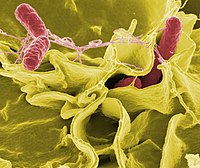
Photo from wikipedia
To the Editor, A very limited amount of data is present in the literature on SARSCoV2 infection in Xlinked agammaglobulinemia (XLA) patients.1 Moreover, it remains unclear the role of vaccination… Click to show full abstract
To the Editor, A very limited amount of data is present in the literature on SARSCoV2 infection in Xlinked agammaglobulinemia (XLA) patients.1 Moreover, it remains unclear the role of vaccination against SARSCoV2 in these subjects.2 IL6 is the main cause of the cytokine storm3 that characterized severe COVID19; notably, the lack of IL6 production by macrophages due to the absence of Bruton tyrosine kinase (BTK) that characterized XLA patients was suggested to be responsible for the mildtomoderate clinical course of infection seen in these patients.4 Specific guidelines dealing with the particularities of treatment for COVID19 in XLA patients are few and unclear. Ponsford et al.5 suggest an individualized stepbystep clinical risk stratification in vaccinated XLA subjects in order to schedule additional vaccine boosters and possibly to estimate postexposure clinical disease severity. In acute SARSCoV2 infection, the administration of monoclonal antibodies and antiviral therapies was suggested, if humoral and Tcellmediated immune responses are impaired, in order to prevent the risk of severe disease. However, an early treatment for patients with mild symptoms within the first few days of the disease may not be feasible. Here, we present a case report of a SARSCoV2infected XLA 12yearold boy; XLA diagnosis was made at 6 years old after lung recurrent infections, which resulted in bilateral bronchiectasis with preserved respiratory function. Since then, he has been regularly treated with replacement immunoglobulins every 15 days. He was vaccinated with three doses of BNT162b2 mRNA vaccine; the last dose has been administrated 2 months before SARSCoV2 infection (Figure 1). He developed mild symptoms such as rhinitis, cough, headache, and sore throat. On day 2, he tested positive at RTPCR for SARSCoV2 strain BA.2 (B.1.1.529.2). He recovered from symptoms on day 7, and he tested negative at RTPCR on day 15. We investigated his immune response to guide the therapeutic approach. We performed immunological analysis during acute infection (AI) and after 1month postCOVID19 diagnosis (PI). On day 5, we performed routine blood analysis to assess complete blood count, hepatorenal function, and inflammatory markers, which all resulted within normal ranges. We evaluated lymphocyte subsets by AQUIOS CL® flow cytometer (Beckman Coulter) using fresh blood samples. A customized antibodies mix was used for this clinical purpose (Beckman Coulter). We evaluated the percentage of T lymphocytes (CD3+/CD4+; CD3+/CD8+) and B lymphocytes (CD19+). The Bcell compartment, as expected, was compromised (CD19+ 4/μL, 0.2%), whereas T cells were in the normal range according to age (CD3+ 1727/μL, 88.2%; CD4+ 1231/μL, 62%; CD8+ 342/μL, 17.2%). The decision was made to treat our patient with Xevudy (Sotrovimab) monoclonal antibodies (500 mg in 8 mL). The drug administration took place on the fifth day after the molecular diagnosis of the infection. No side effects were reported. We did not use the antiviral drug because of the mild clinical course. On plasma collected before monoclonal antibody infusion (day 5) (AI), we evaluated SARSCoV2 neutralization antibody activity (NTA) against SARSCoV2 B.1 (EU) and B.1.1.529 (Omicron) variants by virus neutralization assay as previously described (doi:10.3390/ ijms232214341). Positive NTA threshold was put at a dilution of 1:20. No NTA was found against Omicron, whereas low level against EU (1:20) variant was detected. It is reasonable to assume that, at AI, the neutralizing activity detected, albeit low, is attributable to the immunoglobulin replacement therapy. SARSCoV2specific cellmediated immune responses upon the stimulation of peripheral blood mononuclear cells (PBMCs) were also analyzed. Cells were stimulated with a pool of peptides covering the sequence of the spike of SARSCoV2 virus (BEI Resources Repository at NIH) and stained for flow cytometry analysis. The following antihuman antibodies were used: CD45 Krome Orange, CD4 PC5.5, CD8 PC7, CD45RA FITC, CCR7 PE, CD107a FITC, HLADRII PE, CD20 PC7, and IFNγ APC. Samples acquisition was performed on a CytoFLEXTM flow cytometer system equipped with CytExpert software (Beckman Coulter), and data were analyzed using Kaluza software, version 2.1.1. (Beckman Coulter). No significant differences in CD4+ and CD8+ T effector memory (CD4+/CCR7/CD45RA, CD8+/CCR7/CD45RA) and central memory (CD4+/CCR7+/CD45RA, CD8+/CCR7+/CD45RA) lymphocytes were observed in unstimulated compared with SARSCoV2specific cells at AI (Table 1 and Figure 2). In contrast with these data, SARSCoV2specific IFNγproducing CD8+ T lymphocytes were increased compared with the unstimulated condition.
Journal Title: Pediatric Allergy and Immunology
Year Published: 2023
Link to full text (if available)
Share on Social Media: Sign Up to like & get
recommendations!